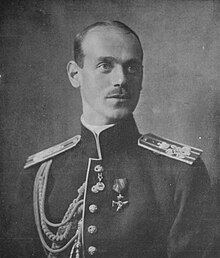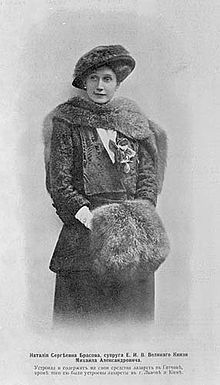George Mikhailovich, Count Brasov
| George Mikhailovich | |
|---|---|
| Count Brasov | |
 | |
| Born | 6 August 1910 Moscow, Russian Empire |
| Died | 21 July 1931 (aged 20) Sens, France |
| Burial | Passy Cemetery, Paris, France |
| Father | Grand Duke Michael Alexandrovich of Russia |
| Mother | Natalia Brasova |
George Mikhailovich, Count Brasov (
Early life

George was born in his mother's
At the time of George's birth, Natalia was still legally married to her second husband, army officer Vladimir Vladimirovich Wulfert. Wulfert and Grand Duke Michael had served in the same regiment, The Dowager Empress's Life Guard Cuirassier Regiment, known as the Blue Cuirassiers, stationed at Gatchina near Saint Petersburg. After the scandal that arose from Michael's affair with Wulfert's wife, Wulfert was transferred to Moscow, and Michael was transferred to the Chernigov Hussars at Orel.[2] Michael and Natalia feared that her husband would try to claim custodial rights over George, and had instituted divorce proceedings,[3] but the divorce was only finalised after George's birth. It was said that Wulfert was bought off with a bribe of 200,000 roubles,[4] and the date of the Wulferts divorce was back-dated, so that George was recognised as Natalia's illegitimate son, though inheriting her noble status, rather than the legitimate child of Wulfert's.[5]
George was baptised on 22 September 1910 at the Church of St Basil of Caesarea in Moscow, by Father Peter Pospelov, and named after his late uncle, Grand Duke George Alexandrovich of Russia, who had died in 1899. His godparents were Aleksei Matveev and Margaret Abakanovich. Matveev was the husband of George's maternal aunt, Olga, and Abakanovich was a family friend who was married to Michael's adjutant. Abakanovich was absent, and George's half-sister, Natalia Sergeyevna Mamontova, Natalia's daughter from her first marriage, stood proxy.[1] On 13 November 1910, Emperor Nicholas II decreed that the boy would be known as George Mikhailovich Brasov, with the surname taken from one of Michael's estates: Brasovo near Orel.[5]
Grand Duke Michael was second in the line of imperial succession after his nephew,
Childhood

In the fall of 1914, at the start of
Michael wrote to Nicholas asking him to legitimise George so, he argued, that the boy would be provided for in the event of Michael's death at the front.[15] Six months later, Nicholas legitimised George by decree, and created him a count.[16] George and his descendants would, however, be excluded from the order of succession.
By 1915, Mrs Bennett was pregnant, so she left the family's service and was replaced by her friend and fellow Englishwoman, Margaret Neame.[17] George's father remained at the front until September 1916, but he was invalided from October with stomach ulcers, and the family spent the winter in the Crimea as Michael recuperated, and then spent Christmas at Brasovo.[18] The Christmas holiday was cut short, however, when a guest's child contracted diphtheria and died.[19] At risk of infection, the family evacuated the estate by snow-bound sleigh ride. It was the last time any of them would see Brasovo.[20]
February Revolution

New Year 1917 was spent back at Gatchina. During the February Revolution two months later, Nicholas II abdicated for himself and his son and nominated Michael to succeed him. Michael declined to accept unless ratified by an elected assembly, and issued a manifesto that recognised the de facto control of the Russian Provisional Government.[21] With the revolutionaries in power, and the influence of the imperial family all but ended, George and his family were placed under house arrest at the villa in Gatchina.[22]
In September 1917, the house arrest was lifted.
In March 1918, George's father was exiled to the remote city of
Exile
On the night of 12–13 June 1918, George's father was shot dead on the outskirts of Perm by the

George was enrolled at
To George's amusement, the idea of him claiming the throne was circulated during his lifetime.
In 1928, George's grandmother, the
George was buried in Passy Cemetery in Paris. In 1952, his mother died from cancer, and she was interred beside him in a grave marked by a Slavonic cross of stone on a marble tomb. (Section 9, near the intersection with the outer wall and Section 8.) The gold inscription reads, Fils et Epouse de S.A.I. Grand Duc Michel de Russie.[38]
Although he had no succession rights due to the morganatic marriage of his parents, George was the last male-line descendant of Alexander III of Russia.
Notes

- ^ a b Crawford and Crawford, p. 104
- ^ Crawford and Crawford, pp. 59–104
- ^ Crawford and Crawford, pp. 94–96
- ^ Letter from Michael Bakhrushin to Pauline Gray, 17 December 1973, Leeds Russian Archive, MS 1363/136, quoted in Crawford and Crawford, p. 107
- ^ a b Crawford and Crawford, p. 107
- ^ Crawford and Crawford, p. 128
- ^ Crawford and Crawford, pp. 129–131
- ^ Crawford and Crawford, pp. 130–132
- ^ Crawford and Crawford, p. 136
- ^ Crawford and Crawford, pp. 138–146
- ^ Crawford and Crawford, pp. 159–160
- ^ Crawford and Crawford, p. 161
- ^ Crawford and Crawford, p. 159
- ^ Crawford and Crawford, p. 178
- ^ Letter from Michael to Nicholas, 15 November 1914, State Archive of the Russian Federation, 601/1301, quoted in Crawford and Crawford, p. 164
- ^ Crawford and Crawford, p. 182
- ^ Crawford and Crawford, p. 209
- ^ Crawford and Crawford, pp. 233–245
- ^ Irina, the daughter of Natalia Brasova's childhood friend Maria Lebedeva
- ^ Crawford and Crawford, p. 246
- ^ Crawford and Crawford, pp. 312–313
- ^ Crawford and Crawford, pp. 327–330
- ^ Crawford and Crawford, p. 332
- ^ Crawford and Crawford, p. 334
- ^ Crawford and Crawford, p. 335
- ^ Crawford and Crawford, p. 344
- ^ a b Margaret Neame: letter to her sister Janet, 16th May 1918
- ^ a b Crawford and Crawford, p. 345
- ^ Crawford and Crawford, pp. 374–377
- ^ Crawford and Crawford, p. 381
- ^ Crawford and Crawford, p. 382
- ^ Crawford and Crawford, p. 385
- ^ a b Crawford and Crawford, p. 390
- ^ a b His half-sister's memoirs, Majolier, Natalia (1940) Stepdaughter to Imperial Russia, London: Stanley Paul, pp. 225–226, quoted in Crawford and Crawford, p. 390
- ^ Crawford and Crawford, p. 389
- ^ Clarke, p. 162
- ^ Crawford and Crawford, p. 391
- ^ Crawford and Crawford, p. 395
References
- Clarke, William (2007). Romanoff Gold: The Lost Fortune of the Tsars, Stroud: Sutton Publishing, ISBN 978-0-7509-4499-1
- Crawford, Rosemary; Crawford, Donald (1997). Michael and Natasha: The Life and Love of the Last Tsar of Russia, London: Weidenfeld & Nicolson, ISBN 978-0-7538-0516-9
